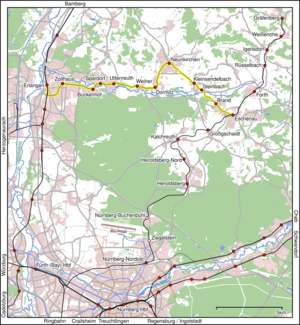Erlangen – Eschenau railway line
| Erlangen – Eschenau (Mittelfr) | |||||||||||||||||||||||||||||||||||||||||||||||||||||||||||||||||||||||||
|---|---|---|---|---|---|---|---|---|---|---|---|---|---|---|---|---|---|---|---|---|---|---|---|---|---|---|---|---|---|---|---|---|---|---|---|---|---|---|---|---|---|---|---|---|---|---|---|---|---|---|---|---|---|---|---|---|---|---|---|---|---|---|---|---|---|---|---|---|---|---|---|---|---|
|
Locomotive shed in Eschenau
| |||||||||||||||||||||||||||||||||||||||||||||||||||||||||||||||||||||||||
| Course book range : | 414f | ||||||||||||||||||||||||||||||||||||||||||||||||||||||||||||||||||||||||
| Route length: | 19.0 km | ||||||||||||||||||||||||||||||||||||||||||||||||||||||||||||||||||||||||
| Gauge : | 1435 mm ( standard gauge ) | ||||||||||||||||||||||||||||||||||||||||||||||||||||||||||||||||||||||||
|
|||||||||||||||||||||||||||||||||||||||||||||||||||||||||||||||||||||||||
The Erlangen – Eschenau railway was a secondary line in Bavaria , it ran from Erlangen via Neunkirchen am Brand to Eschenau .
The nickname ( Seku or Manatee ) used by the population for the train is explained by the following anecdote: The painter who was supposed to put the words “Restoration for the secondary railway” on the station was not quite finished in the evening and so it was written “Restoration zur Seku ... “at the house. Students passing by made fun of the fragment and ensured that the nickname was spread quickly.
The peculiarity of the connection lay in its routing, which did not take place on its own route , as is usually the case with mainline railways , but on or directly next to the road. The tracks led through the middle of the city of Erlangen and through sometimes very narrow local passages. Only in Neunkirchen am Brand this was not possible because of the densely built-up old town center with its town fortifications.
history
The city of Graefenberg tried since 1873 to be connected to the Nuremberg – Cheb railway line , but this failed because of the additional costs. In 1882 the Bavarian state parliament passed the Secondary Railway Act as a prerequisite for the construction of the railway. Construction began in 1885. The first test train drove on November 8, 1886, and the official opening took place on November 17, 1886.
For reasons of cost, most of the railway construction took place on or next to the road and ran through several towns. Locomotives of the Bavarian class D VII were used . The railway generated surpluses in the first few years. With the construction of the Graefenbergbahn from Nürnberg Nordost to Eschenau in 1908, trains ran from Graefenberg to Nürnberg Nordost, passengers from Erlangen to Graefenberg had to change trains in Eschenau.
In 1932, railcars were used for the first time , which ran through to Graefenberg. The travel time from Erlangen to Eschenau was initially reduced from 85 to 60 minutes in the 1930s. Six pairs of trains ran on weekdays and seven on Sundays.
After the Second World War, the “Seku” lost its importance with the rise of motor vehicle traffic, not least because it had to stop at priority roads. After the increasingly frequent accidents, a court order had set the maximum speed at 15 km / h.
On May 1, 1961, the section from Neunkirchen am Brand to Eschenau was closed for all traffic. On February 17, 1963, the last passenger train ran the rest of the route. Although the district had requested the continuation, the Federal Ministry of Transport decided to shut it down. The last freight train ran on December 31, 1963. The line to Eschenau was soon dismantled.
Omnibus traffic as the successor
The successor to the "Seku" is a bus line from Erlangen train station to Eschenau with a connection to the Graefenbergbahn. The former rail bus connection is now operated by the company Schmetterling Reisen as line 209 and is part of the network tariff of the greater Nuremberg area .
Traces of the "Seku"
Traces of the route can still be seen today:
- the strip southeast of platform 1 at Erlangen main station, which is now partially built over with bicycle parking spaces (former platform and platform),
- a wide, now green, central reservation in Werner-von-Siemens-Straße in Erlangen,
- the footpath and bike path southeast of the bus turning loop in Buckenhof on the former railway line,
- the former station building in Uttenreuth, which has been converted into a residential building, opposite the closed butcher's / inn Fürsattel,
- Connecting road between Uttenreuth and Weiher on the former railway embankment (the bike path is the former road),
- the current route of the main street in Dormitz between Karlsbader Strasse and Raiffeisenstrasse,
- the cycle path between Dormitz and Neunkirchen am Brand on the former railway line,
- the former station building in Neunkirchen am Brand, which has been largely faithfully restored,
- the cycle path between Neunkirchen am Brand and Kleinsendelbach on the former railway line,
- the former goods shed in Steinbach; Today the Erlangen-Höchstadt social department store is located at the location of the former stop,
- At the end of Brand in the direction of Eschenau you can see a dam on the left that branches off from the main road. There the tracks of the "Seku" left the street and continued in a left curve towards Eschenau station,
- the restored engine shed in Eschenau
City-suburban railway
Since the 1990s, there are plans for one as a city-suburban railway Erlangen called light rail for the area Erlangen. The east branch of the east-west route from Herzogenaurach to Neunkirchen am Brand (or Uttenreuth) would follow a section of the old Seku route. However, this part of the overall project was dropped after a referendum by the Erlangen-Höchstadt district in April 2015.
literature
- Günther Klebes / Kliesch-Brandes, Friedemann, The Manatee. The history of the local railway from Erlangen to Graefenberg , Junge & Sohn, Erlangen 1989, ISBN 3-87388-014-8 (1st edition) or ISBN 3-87388-015-6 (2nd, revised edition)
- Günther Klebes: The manatee - secondary railway Erlangen-Graefenberg , Eisenbahn-Kurier-Verlag, Freiburg 1978, ISBN 3-88255-852-0
- Official course book, summer 1949, Freiburg 1984 (repr.), ISBN 3-88255-949-7
Web links
Individual evidence
- ↑ Majority opposes StUB, is the L-solution coming? Online edition of the Erlanger Nachrichten from April 19, 2015

